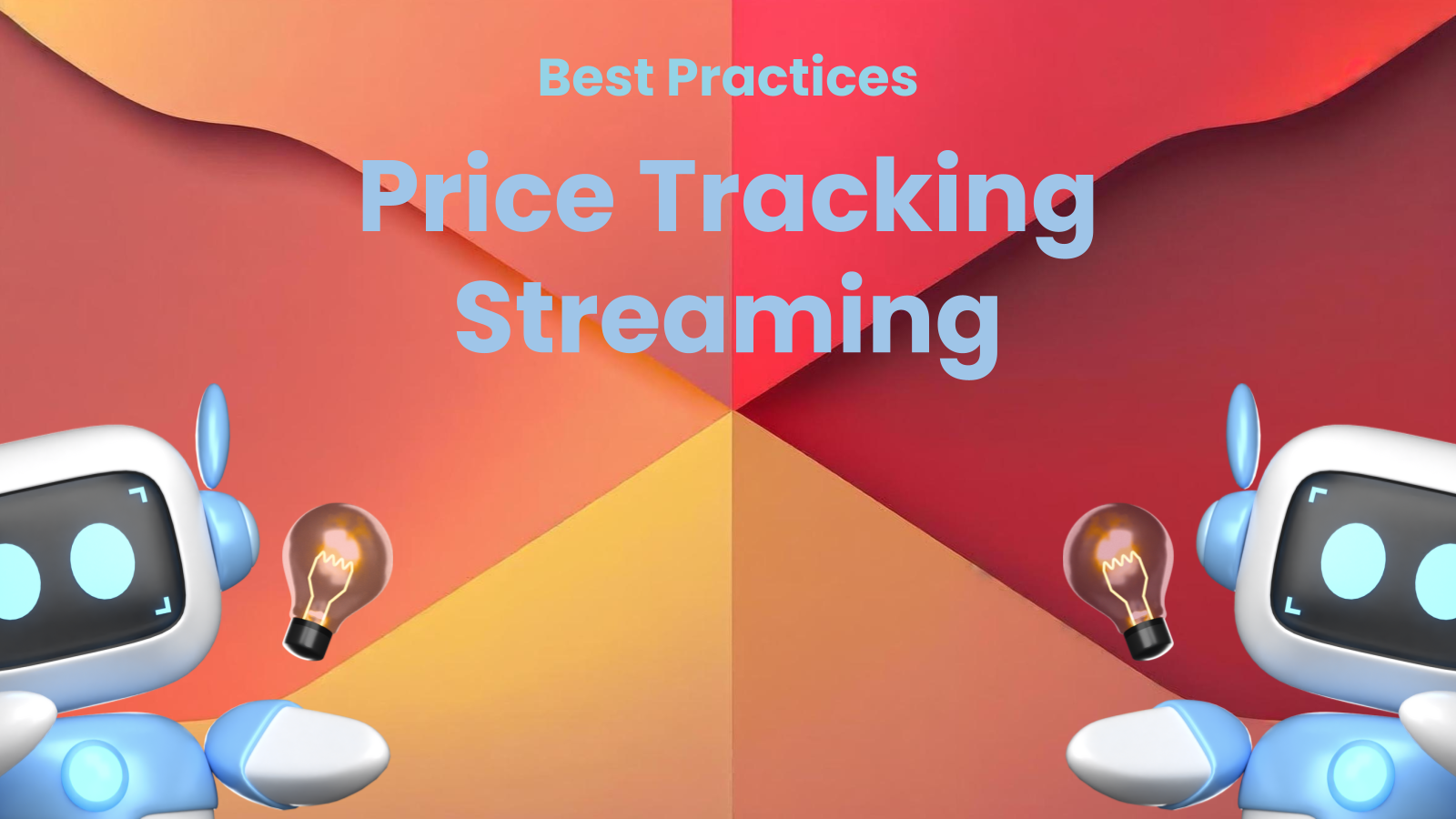Best Practices for Price Tracking Streaming Services

Best Practices for Price Tracking Streaming Services: Never Miss a Deal Again!
In the ever-expanding universe of streaming entertainment, keeping track of your expenses can feel like navigating a black hole. With new platforms launching regularly, existing services changing their pricing structures, and tempting bundles vying for your attention, it's easy to lose sight of how much you're actually spending on your monthly entertainment. That's where price tracking comes in. By implementing effective price tracking strategies, you can optimize your streaming budget, avoid overpaying, and ensure you're always getting the best value for your money. This comprehensive guide explores the best practices for price tracking streaming services, empowering you to become a savvy streamer and take control of your entertainment spending.
Why is Price Tracking Streaming Services Important?
Before diving into the "how," let's understand the "why." Tracking the prices of your streaming services offers numerous benefits:
- Budget Optimization: The most obvious advantage is the ability to monitor your monthly expenses. Streaming subscriptions can quickly add up, and tracking allows you to identify areas where you can cut back or find cheaper alternatives.
- Deal Identification: Streaming services frequently offer promotions, discounts, and bundled deals. Price tracking helps you spot these opportunities and capitalize on them, saving you money in the long run.
- Avoiding Automatic Renewals at Higher Prices: Many services automatically renew subscriptions at the standard rate after a promotional period ends. Tracking prevents you from being caught off guard by unexpected price hikes.
- Informed Decision-Making: When considering adding a new service or switching providers, tracking historical price data allows you to make informed decisions based on pricing trends and potential future changes.
- Negotiating Power: Knowing the prices offered by competitors can give you leverage when negotiating with your current providers for a better deal.
- Staying Up-to-Date: The streaming landscape is constantly evolving. Price tracking helps you stay informed about the latest pricing changes, new service launches, and emerging bundles, allowing you to adapt your streaming strategy accordingly.
- Preventing Subscription Creep: It's easy to sign up for a free trial and forget about it, leading to unwanted subscriptions and recurring charges. Price tracking helps you identify and cancel subscriptions you no longer use or need.
Best Practices for Effective Price Tracking:
Now that we understand the importance of price tracking, let's explore the best practices for implementing a successful tracking strategy:
1. Inventory Your Current Subscriptions:
The first step is to create a comprehensive list of all your current streaming subscriptions. Include the following information for each service:
- Service Name: (e.g., Netflix, Hulu, Disney+, Spotify, Apple TV+)
- Subscription Plan: (e.g., Basic, Standard, Premium, Ad-Supported, Ad-Free)
- Monthly Price: (Include any taxes or additional fees)
- Renewal Date: (The date your subscription is automatically renewed)
- Payment Method: (e.g., Credit Card, PayPal)
- Features/Benefits: (e.g., 4K streaming, number of simultaneous streams, offline downloads)
- Value Proposition: (Why are you subscribed to this service? What do you use it for?)
This inventory will serve as your baseline for tracking and comparing prices. You can use a spreadsheet, a dedicated note-taking app, or a budgeting tool to organize this information.
2. Choose Your Price Tracking Method:
Several methods can be used to track streaming service prices:
- Manual Tracking: This involves manually checking the websites of your subscribed services on a regular basis (e.g., weekly or monthly) to see if there have been any price changes or new deals. This method is free but can be time-consuming and prone to errors.
- Spreadsheet Tracking: Create a spreadsheet with columns for service name, plan, current price, previous price, date of price change, and notes. Update the spreadsheet whenever you notice a price change. This method offers more organization than manual tracking but still requires manual effort.
- Budgeting Apps and Personal Finance Software: Many budgeting apps and personal finance software packages allow you to track your recurring expenses, including streaming subscriptions. These tools can often send you alerts when your subscription prices change. Popular options include Mint, YNAB (You Need a Budget), and Personal Capital.
- Dedicated Price Tracking Websites and Apps: Several websites and apps are specifically designed to track prices for various products and services, including streaming. These tools often use web scraping to automatically monitor prices and send you notifications when prices change. Some examples include CamelCamelCamel (primarily for Amazon, but can be adapted for some services), Pricepulse, and Keepa. While not specifically for streaming, they can be useful for bundled services or services offered through marketplaces.
- Browser Extensions: Some browser extensions can track prices and automatically find coupons and deals while you browse the web. Honey and Rakuten are popular examples, although their effectiveness for streaming services can vary.
- Service-Specific Alerts: Some streaming services allow you to sign up for email alerts about price changes or promotions. Check your account settings to see if this option is available.
Choose the method that best suits your needs and technical skills. For most users, a combination of spreadsheet tracking and budgeting app alerts will be sufficient.
3. Set Up Price Alerts and Notifications:
Regardless of the method you choose, it's crucial to set up price alerts and notifications to stay informed about changes.
- Budgeting Apps: Configure your budgeting app to send you alerts whenever a subscription price changes or a new transaction appears.
- Spreadsheet Reminders: Set reminders in your calendar to manually check your streaming service prices on a regular basis and update your spreadsheet.
- Website and App Notifications: If you're using a dedicated price tracking website or app, customize the notification settings to receive alerts via email, push notifications, or SMS.
- Service-Specific Email Alerts: Subscribe to email newsletters from your streaming services to receive updates about price changes, promotions, and new content.
4. Regularly Review and Update Your Tracking Information:
Price tracking is an ongoing process, not a one-time task. Make it a habit to regularly review and update your tracking information to ensure accuracy.
- Monthly Review: At the end of each month, review your streaming expenses and compare them to your budget. Identify any unexpected price increases or unwanted subscriptions.
- Renewal Date Check: A week or two before each subscription renewal date, double-check the current price and consider whether you still want to continue the service at that price.
- Deal Evaluation: Whenever you see a promotion or bundled deal, carefully evaluate its terms and conditions before signing up. Consider whether the deal aligns with your viewing habits and whether it represents a genuine savings opportunity.
5. Compare Prices and Features:
Don't just track the prices of your current subscriptions; also compare them to the prices and features of competing services.
- Content Libraries: Compare the content libraries of different streaming services to see which ones offer the shows and movies you're most interested in.
- Streaming Quality: Consider the streaming quality offered by each service (e.g., SD, HD, 4K).
- Number of Simultaneous Streams: Compare the number of devices that can stream content simultaneously on each service.
- Offline Downloads: Check if the service allows you to download content for offline viewing.
- User Interface and Experience: Consider the user interface and overall user experience of each service.
- Special Features: Look for unique features such as parental controls, personalized recommendations, and interactive content.
By comparing prices and features, you can make informed decisions about which services offer the best value for your money.
6. Explore Bundled Options and Discounts:
Take advantage of bundled options and discounts to save money on your streaming subscriptions.
- Streaming Bundles: Many streaming services offer bundled subscriptions that combine multiple services at a discounted price. Examples include the Disney Bundle (Disney+, Hulu, ESPN+) and the Paramount+ with Showtime bundle.
- Mobile Carrier Bundles: Some mobile carriers offer free or discounted streaming subscriptions as part of their phone plans. Check with your carrier to see if any such deals are available.
- Internet Provider Bundles: Some internet providers offer bundled packages that include streaming subscriptions.
- Student Discounts: Many streaming services offer discounts to students.
- Military Discounts: Some streaming services offer discounts to military personnel and veterans.
- Other Discounts: Look for discounts offered through employer benefits programs, loyalty programs, and other affiliations.
7. Be Aware of Promotional Periods and Hidden Fees:
Pay close attention to the terms and conditions of promotional offers and be aware of any hidden fees.
- Free Trials: Many streaming services offer free trials, but make sure to cancel before the trial period ends to avoid being charged.
- Promotional Pricing: Be aware that promotional prices often revert to the standard rate after a certain period. Set reminders to cancel or renegotiate your subscription before the price increases.
- Taxes and Fees: Factor in any applicable taxes or fees when calculating the total cost of a streaming subscription.
- Cancellation Policies: Understand the cancellation policies of each service before signing up. Some services may require you to cancel a certain number of days before the renewal date to avoid being charged for the next month.
8. Negotiate with Your Providers:
Don't be afraid to negotiate with your streaming providers for a better deal.
- Threaten to Cancel: Sometimes, simply threatening to cancel your subscription can be enough to get a discount or a promotional offer.
- Mention Competitor Pricing: Let your provider know that you're aware of the prices offered by competitors and that you're considering switching.
- Ask for a Loyalty Discount: If you've been a loyal customer for a long time, ask for a loyalty discount.
- Bundle Your Services: Consider bundling your streaming services with other services offered by the same provider to get a better deal.
9. Cancel Unused Subscriptions:
Regularly review your subscriptions and cancel any that you no longer use or need. This is one of the easiest ways to save money on streaming.
- Evaluate Usage: Ask yourself how often you use each streaming service. If you haven't watched anything on a particular service in several months, it's probably time to cancel.
- Consider Alternatives: If you're only using a service for a few specific shows or movies, consider renting or buying them instead of subscribing to the entire service.
- Temporary Pauses: Some services offer the option to pause your subscription for a period of time, which can be a good alternative to canceling if you plan to use the service again in the future.
10. Document Everything:
Keep a record of all your subscriptions, prices, renewal dates, and any promotional offers you've signed up for. This will help you stay organized and avoid surprises.
- Spreadsheet or Note-Taking App: Use a spreadsheet or note-taking app to track all your streaming subscriptions and related information.
- Email Archive: Create a folder in your email to store all your subscription confirmation emails, promotional offers, and billing statements.
- Calendar Reminders: Set calendar reminders for renewal dates, promotional periods, and cancellation deadlines.
Tools to Aid in Price Tracking:
Here's a quick rundown of some tools that can help streamline your price tracking efforts:
- Mint: A popular budgeting app that automatically tracks your spending and can send you alerts when subscription prices change.
- YNAB (You Need a Budget): A more comprehensive budgeting tool that helps you create a detailed budget and track your progress.
- Personal Capital: A financial management tool that tracks your net worth and provides insights into your spending and investments.
- Google Sheets/Microsoft Excel: Excellent for creating custom spreadsheets to track your subscriptions and prices.
- CamelCamelCamel (Amazon Focused): While primarily for Amazon, it can track the prices of some bundled services offered through Amazon Channels.
- JustWatch: A search engine for streaming services that can help you find where to watch specific shows and movies.
- Streaming Service Websites: The direct source for accurate pricing and plan information.
Conclusion: Take Control of Your Streaming Spending
Price tracking streaming services is an essential skill for anyone who wants to optimize their entertainment budget and avoid overpaying. By following these best practices, you can stay informed about price changes, identify valuable deals, and make informed decisions about which services offer the best value for your money. Remember to regularly review and update your tracking information, compare prices and features, explore bundled options and discounts, and don't be afraid to negotiate with your providers. By taking control of your streaming spending, you can enjoy your favorite shows and movies without breaking the bank. The key is vigilance, organization, and a willingness to adapt to the ever-changing landscape of streaming entertainment. Happy streaming (and saving)!




